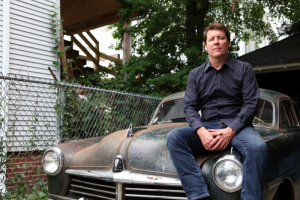Civil Engineering students at the University of Houston’s Cullen College of Engineering are about to get a firsthand lesson in the grim reality of the country’s crumbling infrastructure, thanks to Dan McNichol’s “Dire States” lecture tour.
McNichol, an award-winning author and journalist as well as former White House appointee, is considered one of the nation’s top infrastructure experts. He will be visiting Dr. Reagan Herman’s “Professional Practice in Civil Engineering” class (CIVE 4311) as a part of his “Dire States” tour, in which he travels the country in a 1949 Hudson automobile as a visual demonstration of just how “old, rusty, and energy-defunct” our country’s infrastructure is. According to McNichol’s website, the Hudson was built the same year as many of what he calls “our most structurally deficient bridges.”
One of the missions of the “Dire States” tour is to expand the American understanding of “infrastructure” to include more than just roads and bridges. According to McNichol, much of our country’s failing infrastructure includes water and waste processing facilities, ports, railways, utilities, dams and parks. The 2013 Report Card for America’s Infrastructure, an annual report compiled by the American Society of Civil Engineers, says there is a need for $3.6 trillion in improvements to American infrastructure through 2020.
It may sound like an unsurmountable price tag, but according to McNichol, the country cannot afford to do nothing. McNichol cites ASCE President Greg DiLoreto’s opinion that the nation could see a decrease of over $3 trillion in gross domestic product by 2020 thanks to an increase in failing infrastructure. According to ASCE’s 2012 Report Card for Texas’ Infrastructure, Texas motorists spend an average of $343 to repair damages to their vehicles caused by roads in need of repair. ASCE also estimates that Texas is home to 915 “high-hazard” dams and will require $26 billion for drinking water and $11.5 billion for wastewater facility improvements over the next 20 years.
Perhaps a perfect example of the cost of crumbling infrastructure is the devastation following the levee breach in New Orleans during Hurricane Katrina in 2005. The levees, which were first constructed in the 18th century, breached the morning after the storm hit the Louisiana coastline, causing flooding in 80 percent of the city. The collapse of this vital piece of infrastructure resulted in damages costing over $80 billion.
According to Herman, “It is critical that our civil engineering students are aware of the challenges that accompany our aging public infrastructure.” She calls civil engineers the “custodians” of infrastructure. “The natural approach in civil engineering curriculums is to educate students how to design new infrastructure elements like bridges, water treatment facilities, roads, and so on. But the students we are graduating now will be faced with not only building new infrastructure, but also maintaining the existing aging infrastructure,” Herman said.
Herman pointed out that the typical expectation among U.S. citizens is that when you turn on a tap, you get clean water. “But without proper attention to – and investment in – our public infrastructure, the next generation may not live under the same expectations,” she said.
Dan McNichol will present his Dire States lecture to Herman’s class, as well as any interested students, faculty and professionals, on January 23 at 11:30 a.m. in W122, Engineering Building 2. The Dire States tour is sponsored by Case Construction Equipment.
